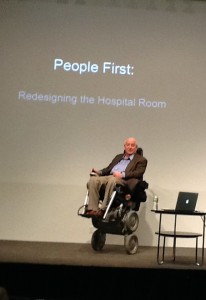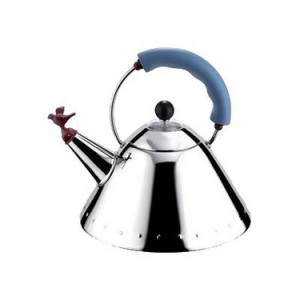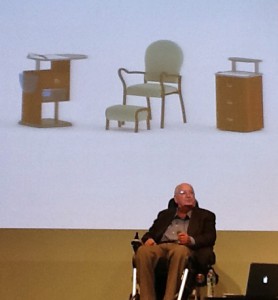 Michael Graves is one of the greatest architects of our, or any, time. He is now dedicating himself to re-imagining what the patient’s experience in a hospital room can be: not just less humiliating and frustrating, but in fact a healing experience in an aesthetically comforting and user-friendly environment.
Michael Graves is one of the greatest architects of our, or any, time. He is now dedicating himself to re-imagining what the patient’s experience in a hospital room can be: not just less humiliating and frustrating, but in fact a healing experience in an aesthetically comforting and user-friendly environment.
Graves, longtime affiliated with Princeton University, is famous among mainstream consumers as one of Target’s first designers of home products for the past 13 years, from teapots and cooking gear to kitchen cleaning accessories. Sadly for us mass consumers, this will be his last year of designing for Target.
He told the standing-room-only crowd at Social Media Week’s health hub in New York City that, “we designed an easy-to-use can opener for Target that lots of people with arthritis can [and do] use,” but the design team didn’t tell Target they were doing so. It’s just an immensely useable device with an enchanting design.
Graves has been in the enchanted design business throughout his career. I have signs of Graves in my own home: his signature is on my favorite teapot from Alessi, along with various household items designed under his name for Target. That’s my treasured Alessi teapot on the right.
 Graves’ passion now is to translate such a design ethos into the health sector. He became a patient several years ago when contracting a virus that’s left him wheelchair dependent — and what a wheelchair, he told us, costing the equivalent of a Mercedes-Benz and utterly useful and mobile, too, for a designer engaged by clients the world over.
Graves’ passion now is to translate such a design ethos into the health sector. He became a patient several years ago when contracting a virus that’s left him wheelchair dependent — and what a wheelchair, he told us, costing the equivalent of a Mercedes-Benz and utterly useful and mobile, too, for a designer engaged by clients the world over.
Graves wants to bring fine and useful design to patients the world over, too. He’s starting with re-imagining the hospital room, having been an inpatient in both acute and rehabilitation settings. He shared photos of himself in a hospital room, a bed covered with a pastel floral blanket (Mario Buatta-designed for the kind of homes you find in Palm Beach), with several potty variations-on-a-theme. Most things in the room weren’t very useable, comforting or aesthetically pleasing. Look at the third photo: these are Graves’ latest hospital patient room furniture designs, and they emerge out of his typical design sensibility: great materials (here, lovely wood), super functionality (note the wastebasket and removable drawer — slideable from either side — that can accompany a patient home), and a chair that is easy to rise from and sit down in with extended arms.
Health Populi’s Hot Points: Listening to Michael Graves, live in person, wax lyrically about too many potties in a hospital room and on his work with The Wounded Warrior Project was a lifetime highlight for me. I only wish I could have given him a hug before he left the venue, but hordes of groupies got ahead of me in the queue of adoration and time ran out.
 What Graves teaches us, above all, is that patient-centered design should be just-that — health environments fully informed — intimately, passionately, no-holds-barred — by patients themselves.
What Graves teaches us, above all, is that patient-centered design should be just-that — health environments fully informed — intimately, passionately, no-holds-barred — by patients themselves.
While Graves wished us all good health, he said it was inevitable that a portion of us in the room would be sitting ‘where’ he was one day, whether through the natural process of aging and living long, through a traumatic accident, or disease. In response to a question on how useful the Americans with Disability Act is, he replied, “The ADA to most people means a railing in the bathroom.”
The issue of sound design in health is therefore every health citizen’s concern. Thank goodness for all of us that Graves has taken on the mission of good design in health.




 Interviewed live on BNN Bloomberg (Canada) on the market for GLP-1 drugs for weight loss and their impact on both the health care system and consumer goods and services -- notably, food, nutrition, retail health, gyms, and other sectors.
Interviewed live on BNN Bloomberg (Canada) on the market for GLP-1 drugs for weight loss and their impact on both the health care system and consumer goods and services -- notably, food, nutrition, retail health, gyms, and other sectors. Thank you, Feedspot, for
Thank you, Feedspot, for  As you may know, I have been splitting work- and living-time between the U.S. and the E.U., most recently living in and working from Brussels. In the month of September 2024, I'll be splitting time between London and other parts of the U.K., and Italy where I'll be working with clients on consumer health, self-care and home care focused on food-as-medicine, digital health, business and scenario planning for the future...
As you may know, I have been splitting work- and living-time between the U.S. and the E.U., most recently living in and working from Brussels. In the month of September 2024, I'll be splitting time between London and other parts of the U.K., and Italy where I'll be working with clients on consumer health, self-care and home care focused on food-as-medicine, digital health, business and scenario planning for the future...